Al-Andalus: Difference between revisions
rmv poor source; neutral point of view is not about "balance" at the expense of WP:RS |
|||
| Line 93: | Line 93: | ||
The non-Muslims were given the status of ''ahl al-[[Dhimmi|dhimma]] ''(the people under protection), with adults paying a "[[Jizya]]" tax, equal to one dinar per year with exemptions for old people, women, children and the disabled. Those who were neither Christians nor Jews, such as Pagans, were given the status of ''[[Majus]]''.<ref>Jayyusi. The legacy of Muslim Spain</ref> |
The non-Muslims were given the status of ''ahl al-[[Dhimmi|dhimma]] ''(the people under protection), with adults paying a "[[Jizya]]" tax, equal to one dinar per year with exemptions for old people, women, children and the disabled. Those who were neither Christians nor Jews, such as Pagans, were given the status of ''[[Majus]]''.<ref>Jayyusi. The legacy of Muslim Spain</ref> |
||
The treatment of non-Muslims in the [[Caliphate]] has been a subject of considerable debate among scholars and commentators, especially those interested in drawing parallels to the coexistence of Muslims and non-Muslims in the modern world. [[María Rosa Menocal]], a specialist in Iberian literature, has argued that "tolerance was an inherent aspect of Andalusian society".<ref>[http://www.twbookmark.com/books/52/0316566888/press_release.html The Ornament of the World by María Rosa Menocal], Accessed, 12 June 2006.</ref> In her view, the Jewish and Christian [[dhimmi]]s living under the Caliphate, while allowed fewer rights than Muslims, were much better off than minorities in Christian parts of Europe. |
The treatment of non-Muslims in the [[Caliphate]] has been a subject of considerable debate among scholars and commentators, especially those interested in drawing parallels to the coexistence of Muslims and non-Muslims in the modern world. [[María Rosa Menocal]], a specialist in Iberian literature, has argued that "tolerance was an inherent aspect of Andalusian society".<ref>[http://www.twbookmark.com/books/52/0316566888/press_release.html The Ornament of the World by María Rosa Menocal], Accessed, 12 June 2006.</ref> In her view, the Jewish and Christian [[dhimmi]]s living under the Caliphate, while allowed fewer rights than Muslims, were much better off than minorities in Christian parts of Europe. |
||
[[History of the Jews in Spain|Jews]] constituted more than 5% of the population.<ref>{{Citation|url=http://countrystudies.us/spain/5.htm|title=Spain — AL ANDALUS}}</ref> Al-Andalus was a key centre of Jewish life during the early [[Middle Ages]], producing important scholars and one of the most stable and wealthy Jewish communities. [[Bernard Lewis]] takes issue with this view, arguing its modern use is ahistorical and apologetic. He argues that Islam traditionally did not offer equality nor even pretended that it did, arguing that it would have been both a "theological as well as a logical absurdity."<ref>Lewis, Bernard W (1984). ''The Jews of Islam'', p. 4.</ref> However, even Bernard Lewis states: |
[[History of the Jews in Spain|Jews]] constituted more than 5% of the population.<ref>{{Citation|url=http://countrystudies.us/spain/5.htm|title=Spain — AL ANDALUS}}</ref> Al-Andalus was a key centre of Jewish life during the early [[Middle Ages]], producing important scholars and one of the most stable and wealthy Jewish communities. [[Bernard Lewis]] takes issue with this view, arguing its modern use is ahistorical and apologetic. He argues that Islam traditionally did not offer equality nor even pretended that it did, arguing that it would have been both a "theological as well as a logical absurdity."<ref>Lewis, Bernard W (1984). ''The Jews of Islam'', p. 4.</ref> However, even Bernard Lewis states: |
||
Revision as of 22:20, 21 November 2012
| History of Al-Andalus |
|---|
|
Muslim conquest (711–732) |
|
Umayyad dynasty of Córdoba (756–1031) |
|
First Taifa period (1009–1110) |
|
Almoravid rule (1085–1145) |
|
Second Taifa period (1140–1203) |
|
Almohad rule (1147–1238) |
|
Third Taifa period (1232–1287) |
|
Emirate of Granada (1232–1492) |
| Related articles |

Al-Andalus (Arabic: الأندلس, trans. al-ʼAndalus; Spanish: Al-Ándalus; Portuguese: Al-Andalus; Aragonese: Al-Andalus; Catalan: Al-Àndalus), also known as the Moorish Iberia, was a medieval Muslim state in parts of what are today Spain, Portugal, Gibraltar, and France. The name more generally describes parts of the Iberian Peninsula and Septimania governed by Muslims (given the generic name of Moors), at various times between 711 and 1492, though the boundaries changed constantly in wars with Christian kingdoms.[1][2][3]
Following the Muslim conquest of Hispania, Al-Andalus was divided into five administrative units, corresponding roughly to modern Andalusia, Galicia and Portugal, Castile and León, Aragon and Catalonia, and Septimania.[4] As a political domain, it successively constituted a province of the Umayyad Caliphate, initiated by the Caliph Al-Walid I (711–750); the Emirate of Córdoba (c. 750–929); the Caliphate of Córdoba (929–1031); and the Caliphate of Córdoba's taifa (successor) kingdoms. Rule under these kingdoms saw a rise in cultural exchange and cooperation between Muslims and Christians. Under the Caliphate of Córdoba, al-Andalus was a beacon of learning, and the city of Córdoba became one of the leading cultural and economic centres in both the Mediterranean Basin and the Islamic world.
In succeeding centuries, Al-Andalus became a province of the Berber Muslim dynasties of the Almoravids and Almohads, later fragmenting into a number of minor states, most notably the Emirate of Granada. With the support of locals, the Almoravids deposed the taifa Muslim princes, after helping to repel Christian attacks on the region by Alfonso VI. It is said that rule under the Almoravids and Almohads saw both a decline in cultural and social exchange.
For much of its history, Al-Andalus existed in conflict with Christian kingdoms to the north, who ultimately overpowered their Muslim neighbors. In 1085, Alfonso VI of León and Castile captured Toledo, starting a gradual Muslim decline until, with the fall of Córdoba in 1236, the Emirate of Granada was the only Muslim territory in what is now Spain. The Portuguese Reconquista culminated in 1249 with the conquest of the Algarve by Afonso III. In 1238, the Emirate of Granada officially became a tributary state to the Kingdom of Castile, then ruled by King Ferdinand III. Finally, on January 2, 1492, Emir Muhammad XII surrendered the Emirate of Granada to Queen Isabella I of Castile, who along with her husband King Ferdinand II of Aragon were known as the "Catholic Monarchs." The surrender ended Al-Andalus as a political entity, though aspects of Muslim rule are still evident in the region.
Etymology
The etymology of "Al-Andalus" is disputed, as is the extent of Iberian territory encompassed by the name over the centuries. The traditional and most widely accepted idea is that the name derives from the Late Latin Vandalucia, meaning "land of the Vandals.[5] The Vandals were a Germanic tribe that invaded the Roman Empire in 408-409 CE and received southern Hispania in the subsequent partition of the peninsula. As a designation for Iberia or its southern portion, the name is first attested to by inscriptions on coins minted by the new Muslim government in Iberia, circa 715 (the uncertainty in the year is due to the fact that the coins were bilingual in Latin and Arabic and the two inscriptions differ as to the year of minting).[6]
At least three specific etymologies have been proposed in Western scholarship, all presuming that the name arose after the Roman period in the Iberian Peninsula's history. Their originators or defenders have been historians. Recently, linguistics expertise has been brought to bear on the issue. Arguments from toponymy (the study of place names), history, and language structure demonstrate the lack of substance in all following proposals, and evidence has been presented that the name predates, rather than postdates, the Roman occupation.[7]
A major objection to all earlier proposals is that the very name Andaluz (the equivalent of Andalus in Spanish spelling) exists in several places in mountainous areas of Castile.[8] Furthermore, the fragment and- is common in Spanish place names, and the fragment -luz also occurs several times across Spain.
Older proposals

The name Andalusia or Vandalusia is traditionally believed to be derived from Vandal (the Germanic tribe that briefly colonized parts of Iberia from 409 to 429). The proposal is sometimes associated with the 19th century historian Reinhart Dozy,[9] but it predates him and he recognized some of its shortcomings. Although he accepted that Al-Andalus derived from Vandal, he believed that geographically it referred only to the harbor from which the Vandals departed Iberia for Africa—the location of which harbour was unknown.[10]
Another proposal is that Andalus is an Arabic language version of the name Atlantis. This idea has recently been defended by the Spanish historian Vallvé, but purely on the grounds that it is allegedly plausible phonetically and would explain several toponymic facts (no historical evidence was offered).[11]
Vallvé writes:
Arabic texts offering the first mentions of the island of Al-Andalus and the sea of al-Andalus become extraordinarily clear if we substitute this expressions with "Atlantis" or "Atlantic". The same can be said with reference to Hercules and the Amazons whose island, according to Arabic commentaries of these Greek and Latin legends, was located in jauf Al-Andalus—that is, to the north or interior of the Atlantic Ocean.
The Island of Al-Andalus is mentioned in an anonymous Arabic chronicle of the conquest of Iberia composed two to three centuries after the fact.[12] It is identified as the location of the landfall of the advance guard of the Moorish conquest of Iberia. The chronicle also says that "Island of al-Andalus" was subsequently renamed "Island of Tarifa". The preliminary conquest force of a few hundred, led by the Berber chief, Tarif abu Zura, seized the first bit of land that is encountered after crossing the Strait of Gibraltar in 710. The main conquest force led by Tariq ibn Ziyad followed them a year later. The landfall, now known in Spain as either Punta Marroquí or Punta de Tarifa, is in fact the southern tip of an islet, presently known as Isla de Tarifa or Isla de las Palomas, just offshore of the Iberian mainland.
This testimony of the Arab chronicle, the modern name Isla de Tarifa, and the above mentioned toponymic evidence that Andaluz is a name of pre-Roman origin taken together lead to the supposition that the Island of Andalus is the present day Isla de Tarifa, which lies just offshore from the modern day Spanish city of Tarifa. The extension of the scope of the designation "Al-Andalus" from a single islet to all of Iberia has several historical precedents.
In the 1980s, the historian Halm, also rejecting the Vandal proposal, originated an innovative alternative.[13] Halm took as his points of departure ancient reports that Germanic tribes in general were reported to have distributed conquered lands by having members draw lots, and that Iberia during the period of Visigothic rule was sometimes known to outsiders by a Latin name, Gothica Sors, whose meaning is 'Gothic lot'. Halm thereupon speculated that the Visigoths themselves might have called their new lands "lot lands" and done so in their own language. However, the Gothic language version of the term Gothica Sors is not attested. Halm claimed to have been able to reconstruct it, proposing that it was *landahlauts (the asterisk is the standard symbol among linguists for a linguistic form that is proposed but has not been attested). Halm then suggested that the hypothetical Gothic language term gave rise to both the attested Latin term, Gothica Sors (by translating the meaning) and the Arabic name, Al-Andalus (by phonetic imitation). However, Halm did not offer evidence (historical or linguistic) that any of the language developments in his argument had in fact occurred.
History
Province of the Caliphate
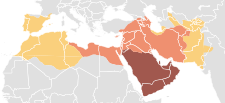

During the caliphate of the Umayyad Caliph Al-Walid I, the Berber commander Tariq ibn-Ziyad led a small force that landed at Gibraltar on April 30, 711, ostensibly to intervene in a Visigothic civil war. After a decisive victory over King Roderic at the Battle of Guadalete on July 19, 711, Tariq ibn-Ziyad, joined by Arab governor Musa ibn Nusayr of Ifriqiya, brought most of the Visigothic Kingdom under Muslim occupation in a seven-year campaign. They crossed the Pyrenees and occupied Visigothic Septimania in southern France.
Most of the Iberian peninsula became part of the expanding Umayyad empire, under the name of Al-Andalus. It was organized as a province subordinate to Ifriqiya, so, for the first few decades, the governors of al-Andalus were appointed by the emir of Kairouan, rather than the Caliph in Damascus. The regional capital was set at Córdoba, and the initial influx of Muslim colonists were widely distributed - Arab colonists were assigned to the south and east, while Berber colonists were scattered across the west and center. [citation needed] Visigothic lords who agreed to recognize Muslim suzerainty were allowed to retain their fiefs (notably, in Murcia, Galicia and the Ebro valley). Resistant Visigoths took refuge in the Cantabrian highlands, where they carved out a rump state, the Kingdom of Asturias.
In the 720s, the Andalusian governors launched several sa'ifa raids into Aquitaine, but were severely defeated by Duke Odo the Great of Aquitaine at the Battle of Toulouse (721). However, after crushing Odo's Berber ally Uthman ibn Naissa on the eastern Pyrenees, Abdul Rahman Al Ghafiqi led an expedition north across the western Pyrenees and defeated the Aquitanian duke, who in turn appealed to the Frankish mayor Charles Martel for assistance, offering to place himself under Carolingian sovereignty. At the Battle of Poitiers in 732, the Andalusian raiding army was defeated by Charles Martel. In 734, the Andalusians launched raids to the east, capturing Avignon and Arles and overran much of Provence. In 737, they climbed up the Rhône valley, reached as far as Burgundy. Charles Martel of the Franks, with the assistance of Liutprand of the Lombards, invaded Burgundy and Provence and expelled the raiders by 739.
Relations between Arabs and Berbers in al-Andalus had been tense in the years after the conquest. Berbers heavily outnumbered the Arabs in the province, and had done the bulk of the fighting, but they had been given the lesser plums of the conquest and were assigned the harsher duties (e.g. garrisoning the more troubled areas). Although some Arab governors had cultivated their Berber lieutenants, others had grievously mistreated them. Mutinies by Berber soldiers were frequent, e.g. in 729, the Berber commander Munnus revolted and managed to carve out a rebel state in Cerdanya for a spell. In 740, a great Berber Revolt erupted in the Maghreb (North Africa). To put down the rebellion, the Umayyad Caliph Hisham dispatched a large Arab army, composed of regiments (junds) of Greater Syria[14] to North Africa. But the great Syrian army was crushed by the Berber rebels at the Battle of Bagdoura (in Morocco). Heartened by the victories of their North African brethren, the Berbers of al-Andalus quickly raised their own revolt. Berber garrisons in northern Spain mutinied, deposed their Arab commanders and organized a large rebel army to march against the strongholds of Toledo, Cordoba and Algeciras. The Andalusian Arab governor, joined by the remnant of the Syrian army (some 10,000) which had fled across the straits, crushed the Berber rebels in a series of ferocious battles in 742. However, a quarrel immediately erupted between the Syrian commanders and the older Andalusian Arabs. The Syrians defeated the Andalusians at the hard-fought Battle of Aqua Portora in August 742, but were too few to impose themselves on the province. The quarrel was settled in 743, with the distribution of the Syrians in regimental fiefs across al-Andalus - the Damascus jund was established in Elvira (Granada), the Jordan jund in Rayyu (Málaga and Archidona), the Jund Filastin jund in Medina-Sidonia and Jerez, the Emesa (Hims) jund in Seville and Niebla and the Qinnasrin jund in Jaén. The Egypt jund was divided between Beja (Alentejo) in the west and Tudmir (Murcia) in the east.[15] The arrival of the Syrians increased substantially the Arab element in the Iberian peninsula and helped deepen the Muslim hold on the south. However, at the same time, unwilling to be governed, the Syrian junds carried on an existence of autonomous feudal anarchy, severely destabilizing the authority of the governor of al-Andalus.
A second significant consequence of the revolt was the expansion of Kingdom of the Asturias, hitherto confined to enclaves in the Cantabrian highlands. After the rebellious Berber garrisons evacuated the northern frontier fortresses, the Christian king Alfonso I of Asturias set about immediately seizing the empty forts for himself, quickly adding the northwestern provinces of Galicia and León to his fledgling kingdom. The Asturians evacuated the Christian populations from the towns and villages of the Galician-Leonese lowlands, creating an empty buffer zone in the Douro River valley (the "Desert of the Duero"). This new emptied frontier would remain roughly in place for the next few centuries as the boundary between the Christian north and the Islamic south. Between this frontier and the Andalusian heartland in the south, the Andalusian state organized three large march territories (thughur) - the lower march (capital initially at Mérida, later Badajoz), the middle march (centered at Toledo) and the upper march (centered at Zaragoza)
The disturbances and disorders also allowed the Franks, now under mayor Pepin the Short, to invade the strategic strip of Septimania in 752, hoping to deprive Andalusians of their easy launching pad for raids into Francia. After a lengthy siege, the last Arab stronghold, the citadel of Narbonne, finally fell to the Franks in 759. Al-Andalus was sealed off at the Pyrenees.[16]
The third consequence of the Berber revolt was the collapse of the authority of the Damascus Caliphate over the western provinces. With the Umayyad Caliphs distracted by the challenge of the Abbasids in the east, the western provinces of the Maghreb and al-Andalus spun out of their control. From around 745, the Fihrids, an illustrious local Arab clan descended from Oqba ibn Nafi al-Fihri, seized power in the western provinces, and ruled them almost as a private family empire of their own - Abd al-Rahman ibn Habib al-Fihri in Ifriqiya and Yūsuf al-Fihri in al-Andalus. The Fihrids welcomed the fall of the Umayyads in the east in 750, and sought to reach an understanding with the Abbasids, hoping they might be allowed to continue their autonomous existence. But when the Abbassids rejected the offer and demanded submission, the Fihrids declared independence and, probably out of spite, invited the deposed remnants of the Umayyad clan to take refuge in their dominions. It was a fateful decision they soon regretted, for the Umayyads, the sons and grandsons of caliphs, had a more legitimate claim to rule than the Fihrids themselves. Rebellious-minded local lords, disenchanted with the autocratic rule of the Fihrids, intrigued with the arriving Umayyad exiles.
Umayyad Emirate and Caliphate of Córdoba
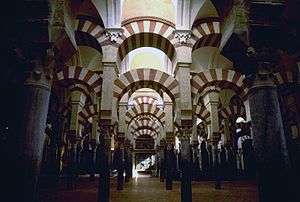
In 756, the exiled Umayyad prince Abd al-Rahman I (nicknamed al-Dākhil, the 'Immigrant') ousted Yūsuf al-Fihri to establish himself as the Emir of Córdoba. He refused to submit to the Abbasid caliph, as Abbasid forces had killed most of his family. Over a thirty year reign, he established a tenuous rule over much of al-Andalus, overcoming partisans of both the al-Fihri family and of the Abbasid caliph.[17]
For the next century and a half, his descendants continued as emirs of Córdoba, with nominal control over the rest of al-Andalus and sometimes parts of western North Africa, but with real control, particularly over the marches along the Christian border, vacillating depending on the competence of the individual emir. Indeed, the power of emir Abdallah ibn Muhammad (circa 900) did not extend beyond Córdoba itself. But his grandson Abd-al-Rahman III, who succeeded him in 912, not only rapidly restored Umayyad power throughout al-Andalus but extended it into western North Africa as well. In 929 he proclaimed himself Caliph, elevating the emirate to a position competing in prestige not only with the Abbasid caliph in Baghdad but also the Shi'ite caliph in Tunis—with whom he was competing for control of North Africa.

The period of the Caliphate is seen as the golden age of al-Andalus. Crops produced using irrigation, along with food imported from the Middle East, provided the area around Córdoba and some other Andalusī cities with an agricultural economic sector by far the most advanced in Europe. Among European cities, Córdoba under the Caliphate, with a population of perhaps 500,000, eventually overtook Constantinople as the largest and most prosperous city in Europe.[18] Within the Islamic world, Córdoba was one of the leading cultural centres. The work of its most important philosophers and scientists (notably Abulcasis and Averroes) had a major influence on the intellectual life of medieval Europe.
Muslims and non-Muslims often came from abroad to study in the famous libraries and universities of al-Andalus after the reconquest of Toledo in 1085. The most noted of these was Michael Scot (c. 1175 to c. 1235), who took the works of Ibn Rushd ("Averroes") and Ibn Sina ("Avicenna") to Italy. This transmission was to have a significant impact on the formation of the European Renaissance.
First Taifa period
The Córdoba Caliphate effectively collapsed during a ruinous civil war between 1009 and 1013, although it was not finally abolished until 1031. Al-Andalus then broke up into a number of mostly independent states called taifas. These were generally too weak to defend themselves against repeated raids and demands for tribute from the Christian states to the north and west, which were known to the Muslims as "the Galician nations",[19] and which had spread from their initial strongholds in Galicia, Asturias, Cantabria, the Basque country and the Carolingian Marca Hispanica to become the Kingdoms of Navarre, León, Portugal, Castile and Aragon and the County of Barcelona. Eventually raids turned into conquests, and in response the taifa kings were forced to request help from the Almoravids, Islamic rulers of the Maghreb. Their desperate maneuver would eventually fall to their disadvantage, however, as the Moravids they had summoned from the south went on to conquer many of the taifa kingdoms.
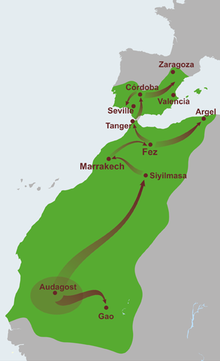
Almoravids, Almohads and Marinids

In 1086 the Almoravid ruler of Morocco Yusuf ibn Tashfin was invited by the Muslim princes in Iberia to defend them against Alfonso VI, King of Castile and León. In that year, Yusuf ibn Tashfin crossed the straits to Algeciras and inflicted a severe defeat on the Christians at the az-Zallaqah. By 1094, Yusuf ibn Tashfin had removed all Muslim princes in Iberia and annexed their states, except for the one at Zaragoza. He regained Valencia from the Christians.
The Almoravids were succeeded in the 12th century by the Almohads, another Berber dynasty, after the victory of Abu Yusuf Ya'qub al-Mansur over the Castilian Alfonso VIII at the Battle of Alarcos. In 1212 a coalition of Christian kings under the leadership of the Castilian Alfonso VIII defeated the Almohads at the Battle of Las Navas de Tolosa. The Almohads continued to rule Al Andalus for another decade, but with much reduced power and prestige; and the civil wars following the death of Abu Ya'qub Yusuf II rapidly led to the re-establishment of taifas. The taifas, newly independent but now weakened, were quickly conquered by Portugal, Castile and Aragon. After the fall of Murcia (1243) and the Algarve (1249), only the Emirate of Granada survived as a Muslim state, but only as a tributary of Castile. Most of its tribute was paid in gold from present-day Mali and Burkina Faso that was carried to Iberia through the merchant routes of the Sahara.
The last Muslim threat to the Christian kingdoms was the rise of the Marinids in Morocco during the 14th century, who took Granada into their sphere of influence and occupied some of its cities, like Algeciras. However, they were unable to take Tarifa, which held out until the arrival of the Castilian Army led by Alfonso XI. The Castilian king, helped by Afonso IV of Portugal and Peter IV of Aragon, decisively defeated the Marinids at the Battle of Salado in 1340 and took Algeciras in 1344. Gibraltar, then under Granadian rule, was besieged in 1349–1350, Alfonso XI along with most of his army perished by the Black Death. His successor, Peter of Castile, made peace with the Muslims and turned his attention to Christian lands, starting a period of almost 150 years of rebellions and wars between the Christian states that secured the survival of Granada.
In 1469 the marriage of Ferdinand of Aragon and Isabella of Castile signaled the launching of the final assault on the Emirate of Granada (Gharnatah). The King and Queen convinced the Pope to declare their war a crusade. The Christians crushed one center of resistance after another and finally, in January 1492, after a long siege, the Moorish sultan, Muhammad XII, surrendered the fortress palace, the renowned Alhambra, itself: see Fall of Granada.
Society
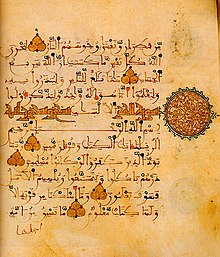
The society of Al-Andalus was made up of three main religious groups: Christians, Muslims and Jews. The Muslims, though united on the religious level, had several ethnic divisions, the main being the distinction between the Berbers and the Arabs. Mozarabs were Christians that had long lived under Muslim rule and so had adopted many Arabic customs, art and words, while still maintaining their Christian rituals and their own Romance languages. Each of these communities inhabited distinct neighborhoods in the cities. In the 10th century a massive conversion of Christians took place, and muladies (Muslims of ethnic Iberian origin) plus Arabs and Berbers comprised eighty percent of the population of Al-Andalus by around 1100.[20][21]
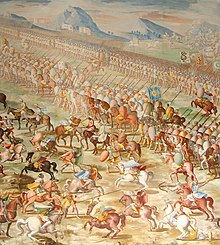
The Berbers, who made up the bulk of the invaders, lived in the mountainous regions of what is now the north of Portugal and in the Meseta Central, while the Arabs settled in the south and in the Ebro Valley in the northeast. [citation needed] The Jews worked mainly as tax collectors, in trade, or as doctors or ambassadors. At the end of the fifteenth century there were about 50,000 Jews in Granada and roughly 100,000 in the whole of Islamic Iberia.[22]
Non-Muslims under the Caliphate
The non-Muslims were given the status of ahl al-dhimma (the people under protection), with adults paying a "Jizya" tax, equal to one dinar per year with exemptions for old people, women, children and the disabled. Those who were neither Christians nor Jews, such as Pagans, were given the status of Majus.[23]
The treatment of non-Muslims in the Caliphate has been a subject of considerable debate among scholars and commentators, especially those interested in drawing parallels to the coexistence of Muslims and non-Muslims in the modern world. María Rosa Menocal, a specialist in Iberian literature, has argued that "tolerance was an inherent aspect of Andalusian society".[24] In her view, the Jewish and Christian dhimmis living under the Caliphate, while allowed fewer rights than Muslims, were much better off than minorities in Christian parts of Europe.
Jews constituted more than 5% of the population.[25] Al-Andalus was a key centre of Jewish life during the early Middle Ages, producing important scholars and one of the most stable and wealthy Jewish communities. Bernard Lewis takes issue with this view, arguing its modern use is ahistorical and apologetic. He argues that Islam traditionally did not offer equality nor even pretended that it did, arguing that it would have been both a "theological as well as a logical absurdity."[26] However, even Bernard Lewis states:
Generally, the Jewish people were allowed to practice their religion and live according to the laws and scriptures of their community. Furthermore, the restrictions to which they were subject were social and symbolic rather than tangible and practical in character. That is to say, these regulations served to define the relationship between the two communities, and not to oppress the Jewish population.
— [27], Bernard Lewis, The Jews of Islam (1984)

The Caliphate treated non-Muslims differently at different times. The longest period of tolerance began after 912, with the reign of Abd-ar-Rahman III and his son, Al-Hakam II where the Jews of Al-Andalus prospered, devoting themselves to the service of the Caliphate of Córdoba, to the study of the sciences, and to commerce and industry, especially to trading in silk and slaves, in this way promoting the prosperity of the country. Southern Iberia became an asylum for the oppressed Jews of other countries.[28][29]
Under the Almoravids and the Almohads there may have been intermittent persecution of Jews,[30] but sources are extremely scarce and do not give a clear picture, though the situation appears to have deteriorated after 1160.[31]
The 11th century saw Muslim pogroms against Jews in Al-Andalus; those occurred in Córdoba in 1011 and in Granada in 1066.[32][33][34] However, massacres of dhimmis are rare in Islamic history.[35]
The Almohads, who had taken control of the Almoravids' Maghribi and Andalusian territories by 1147,[36] far surpassed the Almoravides in fundamentalist outlook, and they treated the non-Muslims harshly. Faced with the choice of either death or conversion, many Jews and Christians emigrated.[37][38] Some, such as the family of Maimonides, fled east to more tolerant Muslim lands,[37] while others went northward to settle in the growing Christian kingdoms.[39]
Rise and fall of Muslim power
Medieval Spain and Portugal was the scene of almost constant warfare between Muslims and Christians. The last Muslim bastion, Nasrid Granada fell around 1492. By this time the Moors in Castile numbered "half a million within the realm, 100,000 had died or been enslaved, 200,000 emigrated, and 200,000 remained as the residual population. Many of the Muslim elite, including Muhammad XII, who had been given the area of the Alpujarra mountain as a principality, found life under Christian rule intolerable and passed over into North Africa"[40]
Culture
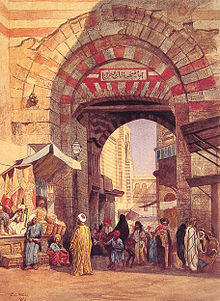
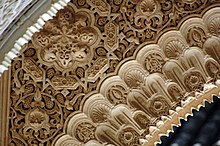
Many tribes, religions and races coexisted in al-Andalus, each contributing to the intellectual prosperity of Andalusia. Literacy in Islamic Iberia was far more widespread than many other nations in the West at the time.[41]
From the earliest days, the Umayyads wanted to be seen as intellectual rivals to the Abbasids, and for Córdoba to have libraries and educational institutions to rival Baghdad's. Although there was a clear rivalry between the two powers, freedom to travel between the two Caliphates was allowed, which helped spread new ideas and innovations over time.
Philosophy
Andalusian philosophy
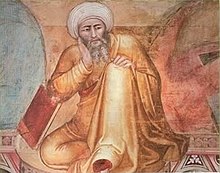
The historian Said Al-Andalusi wrote that Caliph Abd-ar-Rahman III had collected libraries of books and granted patronage to scholars of medicine and "ancient sciences". Later, al-Mustansir (Al-Hakam II) went yet further, building a university and libraries in Córdoba. Córdoba became one of the world's leading centres of medicine and philosophical debate.
However, when Al-Hakam's son Hisham II took over, real power was ceded to the hajib, al-Mansur Ibn Abi Aamir. Al-Mansur was a distinctly religious man and disapproved of the sciences of astronomy, logic and especially astrology, so much so that many books on these subjects, which had been preserved and collected at great expense by Al-Hakam II, were burned publicly. However, with Al-Mansur's death in 1002 interest in philosophy revived. Numerous scholars emerged, including Abu Uthman Ibn Fathun, whose masterwork was the philosophical treatise "Tree of Wisdom". An outstanding scholar in astronomy and astrology was Maslamah Ibn Ahmad al-Majriti (died 1008), an intrepid traveller who journeyed all over the Islamic world and beyond, and who kept in touch with the Brethren of Purity. Indeed, it is said to have been he who brought the 51 "Epistles of the Brethren of Purity" to al-Andalus and who added the compendium to this work, although it is quite possible that it was added later by another scholar of the name al-Majriti. Another book attributed to al-Majriti is the Ghayat al-Hakim "The Aim of the Sage", a book which explored a synthesis of Platonism with Hermetic philosophy. Its use of incantations led the book to be widely dismissed in later years, although the Sufi communities kept studies of it.
A prominent follower of al-Majriti was the philosopher and geometer Abu al-Hakam al-Kirmani. A follower of his in turn was the great Abu Bakr Ibn al-Sayigh, usually known in the Arab world as Ibn Bajjah, "Avempace"
The Andalusian philosopher Averroes (1126–1198) was the founder of the Averroism school of philosophy, and his works and commentaries had an impact on medieval thought in Western Europe. Another influential Andalusian philosopher was Ibn Tufail.
Jewish philosophy and culture
With the tolerance of al-Andalus and the decline of the previous centre of Jewish thought in Babylonia, al-Andalus became the centre of Jewish intellectual endeavours. Poets and commentators like Judah Halevi (1086–1145) and Dunash ben Labrat (920–990) contributed to the cultural life of al-Andalus, but the area was even more important to the development of Jewish philosophy. A stream of Jewish philosophers, cross-fertilizing with Muslim philosophers, (see joint Jewish and Islamic philosophies) culminated in a widely celebrated Jewish thinker of the Middle Ages, Maimonides (1135–1205), though he did not actually do any of his work in al-Andalus, as, when he was 13, his family fled persecution by the Almohads.
Genetic legacy of Muslim rule
A number of studies have tried to find out the genetic impact of non-European Muslim populations on the modern Spanish and Portuguese populations, through comparison of genetic markers in Spain and Portugal with North Africa and the Near East. The most recent and thorough study about Moorish influence in the Iberian Peninsula by Capelli et al. 2009 reported that North African male haplogroups, especially E1b1b1b (E-M81), E1b1b1a-b (M78 derived chromosomes showing the rare DYS439 allele 10, or E-V65) and a subset of J1 (M267 derived), represented, on average, 7-8% of the current Iberian male lineages.[42]
- Historically introduced NW African types in Iberia (Capelli et al. (2009))
| Sample | N | E1b1b1b (M81) | E1b1b1a-b (V65) | J1 (subset) | Total % |
| Spain | 717 | 5.2 | 1 | 1.5 | 7.7 |
| Portugal | 659 | 5 | 0.3 | 1.8 | 7.1 |
| Iberia | 1376 | 5.1 | 0.7 | 1.7 | 7.4 |
See also
Footnotes
- ^ "Para los autores árabes medievales, el término Al-Andalus designa la totalidad de las zonas conquistadas — siquiera temporalmente — por tropas arabo-musulmanas en territorios actualmente pertenecientes a Portugal, España y Francia" ("For medieval Arab authors, al-Andalus designated all the conquered areas — even temporarily —by Arab-Muslim troops in territories now belonging to Portugal, Spain and France"), José Ángel García de Cortázar, V Semana de Estudios Medievales: Nájera, 1 al 5 de agosto de 1994, Gobierno de La Rioja, Instituto de Estudios Riojanos, 1995, p.52.
- ^ "Los arabes y musulmanes de la Edad Media aplicaron el nombre de Al-andalus a todas aquellas tierras que habian formado parte del reino visigodo : la Peninsula Ibérica y la Septimania ultrapirenaica." ("The Arabs and Muslims from the Middle Ages used the name of al-Andalus to all those lands that were formerly part of the Visigothic kingdom: the Iberian Peninsula and Septimania"), Eloy Benito Ruano, Tópicos y realidades de la Edad Media, Real Academia de la Historia, 2000, p.79.
- ^ "Andalus, al-" Oxford Dictionary of Islam. John L. Esposito, Ed. Oxford University Press. 2003. Oxford Reference Online. Oxford University Press. Accessed 12 June 2006.
- ^ Joseph F. O'Callaghan, A History of Medieval Spain , Cornell University Press, 1983, p.142
- ^ http://www.etymonline.com/index.php?term=Andalusia
- ^ Bossong 2002[online]:1
- ^ Bossong 2002
- ^ The village of Andaluz (41°31', -2°49') lies at the foot of Andaluz Mountain on the Duero River in the province of Soria, and within 10 km of it are the villages of Torreandaluz and Centenera de Andaluz. A brook named Andaluz is said to flow in the province of Guadalajara out of the Cueva de la Hoz (41°00', -2°18'). Bossong[online]:10-11, but the coordinates given are according to Google Maps and differ slightly from those in Bossong.
- ^ Dozy, Reinhart P. 1881. Recherches sur l'histoire et la littérature des Arabes d'Espagne pendant le Moyen-Age.
- ^ Bossong 2002[online]:2
- ^ Vallvé Bermejo, Joaquín. 1986. The Territorial Divisions of Muslim Spain. Madrid: CSIC (Consejo Superior de Investigaciones Científicas).
- ^ Bossong[online]:3. The document in question is the Akhbar Majmu'a fi fath Al-Andalus, "Collection of traditions on the conquest of al-Andalus". It was published in Spanish translation in 1867 by Emilio Lafuente y Alcántara. Its subtitle indicates it dates from the 11th c., but several historians today say the 10th c. instead, during the rule of caliph 'Abd al-Rahman III.
- ^ Halm 1989
- ^ Specifically, 27,000 Syrian troops were composed of 6,000 men from each of the four main Syrian junds of Jund Dimashq (Damascus), Jund Hims (Homs), Jund al-Urdunn (Jordan), and Jund Filastin (Filastin), plus 3,000 from Jund Qinnasrin. An additional 3,000 were picked up in Egypt. See R. Dozy (1913) Spanish Islam: A History of the Muslims in Spain (translated by Francis Griffin Stokes from the Spanish Histoire de Musulmans d'Espagne) Chatto & Windus, London, page 133
- ^ Levi-Provençal, (1950: p.48); Kennedy (1996: p.45).
- ^ Franco Cardini, Europe and Islam , Wiley-Blackwell, 2001, p.9
- ^ Roger Collins, "The Arab Conquest of Spain, 710-797", pp. 113-140 & 168-182.
- ^ Tertius Chandler. Four Thousand Years of Urban Growth: An Historical Census (1987), St. David's University Press (etext.org). ISBN 0-88946-207-0.
- ^ Khaldun. The Muqaddimah
- ^ Glick 1999, Chapter 5: Ethnic Relations.
- ^ "The rate of conversion is slow until the tenth century (less than one-quarter of the eventual total number of converts had been converted); the explosive period coincides closely with the reign of 'Abd al-Rahmdn III (912-961); the process is completed (eighty percent converted) by around 1100. The curve, moreover, makes possible a reasonable estimate of the religious distribution of the population. Assuming that there were seven million Hispano-Romans in the peninsula in 711 and that the numbers of this segment of the population remained level through the eleventh century (with population growth balancing out Christian migration to the north), then by 912 there would have been approximately 2.8 million indigenous Muslims (muwalladûn) plus Arabs and Berbers. At this point Christians still vastly outnumbered Muslims. By 1100, however, the number of indigenous Muslims would have risen to a majority of 5.6 million.", (Glick 1999, Chapter 1: At the crossroads of civilization)
- ^ Wasserstein, 1995, p. 101.
- ^ Jayyusi. The legacy of Muslim Spain
- ^ The Ornament of the World by María Rosa Menocal, Accessed, 12 June 2006.
- ^ Spain — AL ANDALUS
- ^ Lewis, Bernard W (1984). The Jews of Islam, p. 4.
- ^ Bernard Lewis 1984, p. 26
- ^ Stavans, 2003, p. 10.
- ^ Kraemer, 2005, pp. 10–13.
- ^ O'Callaghan, 1975, p. 286.
- ^ Roth, 1994, pp. 113–116.
- ^ Frederick M. Schweitzer, Marvin Perry., Anti-Semitism: myth and hate from antiquity to the present, Palgrave Macmillan, 2002, ISBN 0-312-16561-7, pp. 267–268.
- ^ Granada by Richard Gottheil, Meyer Kayserling, Jewish Encyclopedia. 1906 ed.
- ^ Harzig, Hoerder and Shubert, 2003, p. 42.
- ^ Lewis, Bernard (1987) [1984], The Jews of Islam, Princeton, N.J.: Princeton University Press, pp. 44–45, ISBN 978-0-691-00807-3, LCCN 8442575, OCLC 17588445
{{citation}}: Check|lccn=value (help) - ^ Islamic world. (2007). In Encyclopædia Britannica. Retrieved September 2, 2007, from Encyclopædia Britannica Online.
- ^ a b Frank and Leaman, 2003, pp. 137–138.
- ^ The Almohads
- ^ Kraemer, 2005, pp. 16–17.
- ^ Henry Kamen, Spain 1469-1714 A Society of Conflict Third edition, pp 37–38
- ^ Previte-Orton (1971), vol. 1, pg. 377
- ^ Capelli, Cristian; Onofri, Valerio; Brisighelli, Francesca; Boschi, Ilaria; Scarnicci, Francesca; Masullo, Mara; Ferri, Gianmarco; Tofanelli, Sergio; Tagliabracci, Adriano (2009), "Moors and Saracens in Europe: Estimating the medieval North African male legacy in southern Europe", European Journal of Human Genetics, 17 (6): 848–52, doi:10.1038/ejhg.2008.258, PMC 2947089, PMID 19156170.See table
References
- Farmer, Henry George (1978), Historical facts for the Arabian musical influence, Ayer Publishing, ISBN 978-0-405-08496-6
{{citation}}: Invalid|ref=harv(help) - Saliba, George; Sezgin, F. (1981), "Review: Geschichte des arabischen Schriftiums. Band VI: Astronomie bis ca. 430 H by F. Sezgin", Journal of the American Oriental Society, 101 (2): 219–221, doi:10.2307/601763, JSTOR 601763.
{{citation}}: Invalid|ref=harv(help) - Glick, Thomas (1999). "Islamic and Christian Spain in the Early Middle Ages: Comparative Perspectives on Social and Cultural Formation". Retrieved 23 October 2011.
{{cite web}}: Invalid|ref=harv(help)
Bibliography
- Alfonso, Esperanza, 2007. Islamic culture through Jewish eyes: al-Andalus from the tenth to twelfth century. New York, NY: Routledge. ISBN 978-0-415-43732-5
- Al-Djazairi, S.E. 2005. The Hidden Debt to Islamic Civilisation. Bayt Al-Hikma Press. ISBN 0-9551156-1-2
- Bossong, Georg. 2002. Der Name Al-Andalus: Neue Überlegungen zu einem alten Problem. In David Restle and Dietmar Zaefferer, eds, Sounds and systems: studies in structure and change. A festschrift for Theo Vennemann. Berlin: Mouton de Gruyter. pp. 149–164. (In German) Also available online: see External Links below.
- Cohen, Mark. 1995. Under Crescent and Cross: The Jews in the Middle Ages Princeton University Press. ISBN 0-691-01082-X
- Collins, Roger. 1989. The Arab Conquest of Spain, 710–797, Blackwell. ISBN 0-631-19405-3
- Frank, Daniel H. and Leaman, Oliver. 2003. The Cambridge Companion to Medieval Jewish Philosophy. Cambridge University Press. ISBN 0-521-65574-9
- Gerli, E. Michael, ed., 2003. Medieval Iberia: an encyclopedia. New York. ISBN 0-415-93918-6
- Halm, Heinz. 1989. Al-Andalus und Gothica Sors. Der Islam 66:252–263.
- Hamilton, Michelle M., Sarah J. Portnoy, and David A. Wacks, eds. 2004. Wine, Women, and Song: Hebrew and Arabic Literature in Medieval Iberia. Newark, Del.: Juan de la Cuesta Hispanic Monographs.
- Harzig, Christiane, Hoerder, Dirk and Shubert, Adrian. 2003. The Historical Practice in Diversity. Berghahn Books. ISBN 1-57181-377-2
- Jayyusi, Salma Khadra, ed. 1994. The legacy of Muslim Spain. 2 vol. Chief consultant to the editor, Manuela Marín. Leiden: Brill. [Originally published 1992 in German.]
- Kennedy, Hugh. 1996. Muslim Spain and Portugal: A Political History of al-Andalus, Longman. ISBN 0-582-49515-6
- Kraemer, Joel. 1997. Comparing Crescent and Cross (book review). The Journal of Religion, 1997 July, 77(3):449–454.
- Kraemer, Joel. 2005. Moses Maimonides: An Intellectual Portrait. In Kenneth Seeskin, ed., The Cambridge Companion to Maimonides. Cambridge University Press. ISBN 0-521-81974-1
- Kraemer, Joel. 2008. Maimonides : the life and world of one of civilization's greatest minds. New York: Doubleday. ISBN 0-385-51199-X
- Lafuente y Alcántara, Emilio, translator. 1867. Ajbar Machmua (colección de tradiciones): crónica anónima del siglo XI / dada a luz por primera vez, traducida y anotada por Emilio Lafuente y Alcántara. Madrid: Real Academia de la Historia y Geografía. In Spanish and Arabic. Also available in the public domain online, see External Links.
- Luscombe, David et al., eds. 2004. The New Cambridge Medieval History: Volume 4, c.1024–c.1198, Part 1. Cambridge University Press. ISBN 0-521-41411-3
- Marcus, Ivan G.,1985. Beyond the Sepahrdic mystique. in Orim, vol. 1, 35-53.
- Marín, Manuela et al., eds. 1998. The Formation of Al-Andalus: History and Society. Ashgate. ISBN 0-86078-708-7
- Menocal, Maria Rosa. 2002. Ornament of the World: How Muslims, Jews, and Christians Created a Culture of Tolerance in Medieval Spain. Back Bay Books. ISBN 0-316-16871-8
- Monroe, James T. 1970. Islam and the Arabs in Spanish scholarship : (Sixteenth century to the present). Leiden.
- Monroe, James T. 1974. Hispano-Arabic Poetry: A Student Anthology. Berkeley: University of California Press.
- Netanyahu, Benzion. 1995. The Origins Of The Inquisition In Fifteenth Century Spain. Random House ISBN 0-679-41065-1
- O'Callaghan, Joseph F. 1975. A History of Medieval Spain. Cornell University Press. ISBN 0-8014-9264-5
- Omaar, Rageh. 2005. An Islamic History of Europe. video documentary, BBC 4, August 2005.
- Reilly, Bernard F. 1993. The Medieval Spains. Cambridge University Press. ISBN 0-521-39741-3
- Roth, Norman. 1994. Jews, Visigoths and Muslims in Medieval Spain: Cooperation and Conflict. Leiden: Brill. ISBN 90-04-06131-2
- Sanchez-Albornoz, Claudio. 1974. El Islam de España y el Occidente. Madrid: Espasa-Calpe. Colección Austral; 1560. [Originally published in 1965 in the conference proceedings, L'occidente e l'islam nell'alto medioevo: 2-8 aprile 1964, 2 vols. Spoleto: Centro Italiano di studi sull'Alto Medioevo. Series: Settimane di studio del Centro Italiano di studi sull'Alto Medioevo; 12. Vol. 1:149–308.]
- Schorsch, Ismar, 1989. The myth of Sephardic supremacy, in The Leo Baeck Institute Yearbook 34, 47-66
- Stavans, Ilan. 2003. The Scroll and the Cross: 1,000 Years of Jewish-Hispanic Literature. London: Routledge. ISBN 0-415-92930-X
- Wasserstein, David J. 1995. Jewish élites in Al-Andalus. In Daniel Frank (Ed.). The Jews of Medieval Islam: Community, Society and Identity. Brill. ISBN 90-04-10404-6
External links
- Paper by Georg Bossong evaluating proposals for the etymology of "al-Andalus". In German.
- Photocopy of the Ajbar Machmu'a, translated by Lafuente 1867
- The routes of al-Andalus (from the UNESCO web site)
- History and influences of Andalusian music
- The Library of Iberian Resources Online
- Al-Andalus Chronology and Photos
- Christian Martyrs in Muslim Spain by Kenneth Baxter Wolf
- The Musical Legacy of Al-Andalus – historical maps, photos, and music showing the Great Mosque of Córdoba and related movements of people and culture over time
- Patricia, Countess Jellicoe, 1992, The Art of Islamic Spain, Saudi Aramco World
- "Cities of Light: The Rise and Fall of Islamic Spain" (documentary film)


